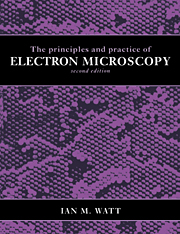Book contents
- Frontmatter
- Contents
- Preface to first edition
- Preface to second edition
- 1 Microscopy with light and electrons
- 2 Electron–specimen interactions: processes and detectors
- 3 The electron microscope family
- 4 Specimen preparation for electron microscopy
- 5 The interpretation and analysis of micrographs, pages 189 to 223
- The interpretation and analysis of micrographs, pages 224 to 262
- 6 Analysis in the electron microscope
- 7 Specialised EM- and other microscopical and analytical techniques
- 8 Examples of the use of electron microscopy
- Appendixes
- Bibliography
- Name index
- Subject index
1 - Microscopy with light and electrons
Published online by Cambridge University Press: 05 June 2012
- Frontmatter
- Contents
- Preface to first edition
- Preface to second edition
- 1 Microscopy with light and electrons
- 2 Electron–specimen interactions: processes and detectors
- 3 The electron microscope family
- 4 Specimen preparation for electron microscopy
- 5 The interpretation and analysis of micrographs, pages 189 to 223
- The interpretation and analysis of micrographs, pages 224 to 262
- 6 Analysis in the electron microscope
- 7 Specialised EM- and other microscopical and analytical techniques
- 8 Examples of the use of electron microscopy
- Appendixes
- Bibliography
- Name index
- Subject index
Summary
As the unaided human eye moves closer to an object it produces in the brain of the observer a progressively larger and more detailed image until the eye is about 25 cm from the object, at the so-called near point of the eye. The observer's eye cannot focus on objects closer than this and the image rapidly becomes blurred as the distance decreases further. What is now needed is a device to give the effect of moving closer but with the enlarged image still appearing no closer than the near point; that is, to help the human eye to see smaller detail than it could unaided. This device is a magnifying system or microscope which may take one of a variety of forms to be described in this book. It may produce an aerial image in space, in which case only one person at a time can see it, or it may form the image on a screen or photographic material so that several people can view it or it can be reproduced elsewhere. Before looking into the types of microscope which are available we can consider the very wide range of objects which are to be examined, a range from postage stamps and fabrics down to the individual atoms of which matter is composed. This range of dimensions covers six orders of magnitude, requiring enlargements up to millions of times greater than life-size. Such enlargements are beyond the capability of traditional microscopes and this book endeavours to explain the new technology which makes it possible to meet these requirements.
- Type
- Chapter
- Information
- The Principles and Practice of Electron Microscopy , pp. 1 - 29Publisher: Cambridge University PressPrint publication year: 1997

